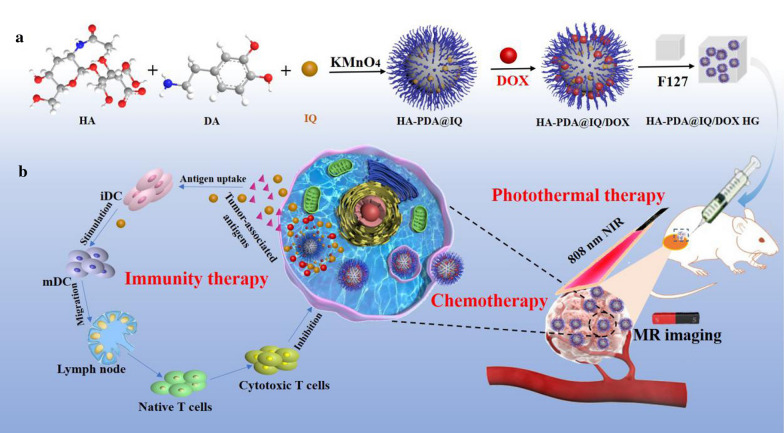- Record: found
- Abstract: found
- Article: found
NIR responsive tumor vaccine in situ for photothermal ablation and chemotherapy to trigger robust antitumor immune responses

Read this article at
Abstract
Background
Therapeutic tumor vaccine (TTV) that induces tumor-specific immunity has enormous potentials in tumor treatment, but high heterogeneity and poor immunogenicity of tumor seriously impair its clinical efficacy. Herein, a novel NIR responsive tumor vaccine in situ (HA-PDA@IQ/DOX HG) was prepared by integrating hyaluronic acid functionalized polydopamine nanoparticles (HA-PDA NPs) with immune adjuvants (Imiquimod, IQ) and doxorubicin (DOX) into thermal-sensitive hydrogel.
Results
HA-PDA@IQ NPs with high photothermal conversion efficiency (41.2%) and T 1-relaxation efficiency were using HA as stabilizer by the one-pot oxidative polymerization. Then, HA-PDA@IQ loaded DOX via π-π stacking and mixed with thermal-sensitive hydrogel to form the HA-PDA@IQ/DOX HG. The hydrogel-confined delivery mode endowed HA-PDA@IQ/DOX NPs with multiple photothermal ablation performance once injection upon NIR irradiation due to the prolonged retention in tumor site. More importantly, this mode enabled HA-PDA@IQ/DOX NPs to promote the DC maturation, memory T cells in lymphatic node as well as cytotoxic T lymphocytes in spleen.
Related collections
Most cited references41
- Record: found
- Abstract: not found
- Article: not found
Dopamine-melanin colloidal nanospheres: an efficient near-infrared photothermal therapeutic agent for in vivo cancer therapy.
- Record: found
- Abstract: found
- Article: not found
Radiotherapy and immunotherapy: a beneficial liaison?

- Record: found
- Abstract: found
- Article: found
